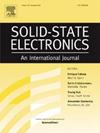器件布局对mosfet自热萃取的影响
IF 1.4
4区 物理与天体物理
Q3 ENGINEERING, ELECTRICAL & ELECTRONIC
引用次数: 0
摘要
本文分析了器件布局对自热提取的影响,并从寄生串联电阻和热释放路径的角度对其进行了分析。具体来说,研究了栅极电阻技术中使用的四端(4T)栅极接入结构对SH表征的影响。为了评估SH参数,使用了射频表征技术,其中包括在宽频率范围内测量s参数。本研究比较了基于相同核心MOSFET的两个器件:一个具有4T栅极接入结构,另一个没有这些额外的接入。实验证明,该器件具有较低的热阻。除了通过4T栅极通道可以解释这一观察结果的冷却之外,可以看到寄生串联电阻也可以影响通过射频技术提取热阻。通过PDK模拟,进一步探讨了串联电阻对射频技术提取SH的影响。事实证明,即使对于相同的核心器件,布局也会影响提取的热参数。本文章由计算机程序翻译,如有差异,请以英文原文为准。
Impact of Device Layout on Self-Heating Extraction in MOSFETs
This work analyses the impact of device layout on self-heating (SH) extraction and treats it in terms of parasitic series resistance and heat evacuation paths. Specifically, the impact of having four-terminal (4T) gate access structures used in gate resistance technique for SH characterization is investigated. To evaluate the SH parameters, the RF characterization technique is utilized, which includes measuring S-parameters over a wide frequency range. Two devices are compared in this study based on the same core MOSFET: one with the 4T gate access structure and one without these additional accesses. It is experimentally demonstrated that a lower thermal resistance is observed for the 4T device. Apart from cooling through the 4T gate accesses which could explain this observation, it is seen that parasitic series resistances could also affect the extraction of thermal resistance through the RF technique. Through PDK simulations, the impact of the series resistances on SH extraction using the RF technique is explored further. The fact that even for the same core device the layout can affect the extracted thermal parameters is evidenced.
求助全文
通过发布文献求助,成功后即可免费获取论文全文。
去求助
来源期刊

Solid-state Electronics
物理-工程:电子与电气
CiteScore
3.00
自引率
5.90%
发文量
212
审稿时长
3 months
期刊介绍:
It is the aim of this journal to bring together in one publication outstanding papers reporting new and original work in the following areas: (1) applications of solid-state physics and technology to electronics and optoelectronics, including theory and device design; (2) optical, electrical, morphological characterization techniques and parameter extraction of devices; (3) fabrication of semiconductor devices, and also device-related materials growth, measurement and evaluation; (4) the physics and modeling of submicron and nanoscale microelectronic and optoelectronic devices, including processing, measurement, and performance evaluation; (5) applications of numerical methods to the modeling and simulation of solid-state devices and processes; and (6) nanoscale electronic and optoelectronic devices, photovoltaics, sensors, and MEMS based on semiconductor and alternative electronic materials; (7) synthesis and electrooptical properties of materials for novel devices.
 求助内容:
求助内容: 应助结果提醒方式:
应助结果提醒方式:


